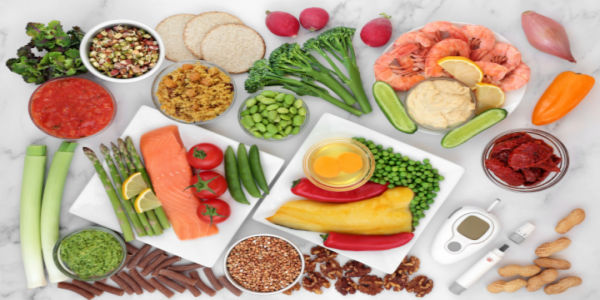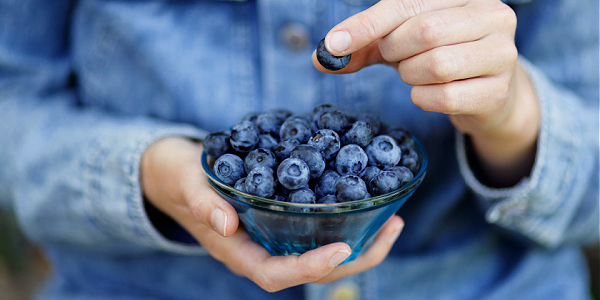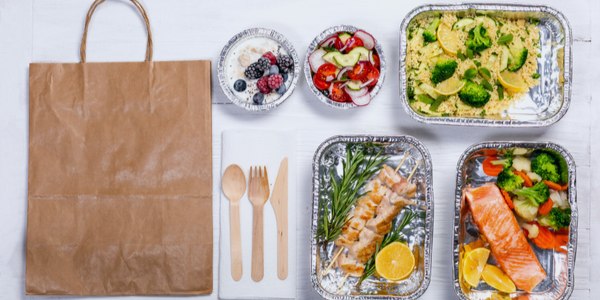
Searching for foods that don’t spike glucose? If you have been diagnosed with type 2 diabetes or are just trying to regulate blood sugar levels, finding snacks and meals full of foods that won’t raise blood sugar is key.
These diabetes-friendly foods can be the building blocks of healthy, satisfying meals. Ahead, find a full list of foods that do not raise blood sugar.
How Does Food Impact Blood Sugar?
To understand how food can impact blood glucose (AKA blood sugars), it’s important to first know the three main macronutrients in food. Macronutrients are the nutrients your body uses in the largest amounts, and they contain different amounts of micronutrients—like vitamins, minerals, and phytochemicals (beneficial plant compounds).
Mastering Macronutrients
The three main macronutrients in food are carbohydrates, protein, and fat. Each type of macronutrient can affect blood sugar in a different way. For example, foods containing carbohydrates have a higher impact on blood sugar since carbs generally have a higher glucose level.
Carbohydrates have a unique effect on blood sugar. Within 15-30 minutes after ingestion, the carbohydrates you consumed as part of your meal or snack can raise your blood sugar. If you are diabetic, testing your blood sugar levels regularly allows you to adjust insulin (a key hormone in balancing blood sugar) administration to your meals.
The order in which you eat your food can also impact your levels of blood sugar. In a recent study, researchers found that eating vegetables or protein before carbohydrates may lower glucose levels significantly. Since complications of diabetes can lead to disease and even death, this understanding is helping doctors and dietitians to improve diet recommendations.
Avoiding a spike in blood sugar involves being aware of how much glucose a certain food contains. You can usually assess this by looking at the number of carbohydrates and added sugars in a food.
Comparing the number of carbohydrates to the amount of blood sugar-balancing nutrients—like healthy fats, protein, fiber—can help you decide if a specific food is right for you.
Understanding Glycemic Index & Glycemic Load
The glycemic index (GI) is another way to measure the effect food has on blood sugars. Foods that are higher on the scale are digested and absorbed more quickly, causing swift changes in blood sugar.
GI uses a scale from 0 to 100 to assess the effect food will have on blood sugar levels. Foods are ranked according to where they fall on the scale:
• Low GI: 1-55
• Medium GI: 56-69
• High GI: 70+
Since GI values generally come from a research setting where foods are compared to an equal amount of sugar, scientists further refined the process of predicting changes in blood glucose by developing glycemic load (GL).
Glycemic load takes into account the average portion size consumed during a meal. Unlike the GI, GL operates on a smaller scale—specifically 1 to 60—with the following ranges:
• Low GL: 1-10
• Medium GL: 11-19
• High GL: 20+
To illustrate GI versus GL, it is helpful to take a look at blueberries. The GI for blueberries is 53, which may be perceived as bordering the medium range. However, when you take a look at the GL for blueberries, ¼ cup comes in at 2.4—which is definitively low.
When we use the measures of GI and GL for blueberries, we can see that this small but delicious fruit can make a sweet substitution for sugar without raising blood sugars. For example, you could add blueberries to oatmeal, yogurt, or smoothies in the morning to help keep blood sugars balanced—without sacrificing taste!
You don’t have to use GI or GL when making food decisions. However, understanding where certain foods fall on the scales can help you make more informed food decisions.
List of Foods That Do Not Raise Blood Sugar
The following lists of low GI and low GL foods can help reduce your risk of diabetes (or help you regulate your blood sugars if you already have diabetes). Remember, mixing and matching these foods for balanced meals, as opposed to obsessing over or only eating one type of food, can ensure you get all the nutrients you need.
While the composition of these foods is blood sugar-friendly, keep in mind that portion sizes still matter.
Fruits
Fruits are often demonized for containing higher amounts of natural sugars. However, fruits contain plenty of other vitamins and minerals to make eating them worth your while.
Some fruity foods that can help balance blood sugar include:
1. Apples
2. Apricots
3. Blueberries
4. Cherries
5. Grapefruit
6. Grapes
7. Kiwi
8. Mango
9. Orange
10. Pear
11. Peach
12. Pineapple
13. Plums
14. Prunes
15. Raspberries
16. Strawberries
Vegetables
Like fruits, vegetables are packed with a plethora of nutrients. As mentioned above, vegetables can help balance your blood sugar, especially when you consume them at the beginning of your meal.
The following foods are great ideas to incorporate to your next snack or meal:
17. Asparagus
18. Bell Peppers
19. Cabbage
20. Carrots
21. Celery
22. Corn
23. Cucumber
24. Eggplant
25. Leafy greens—like arugula, lettuce, spinach, kale
26. Mushrooms
27. Onions
28. Peas
29. Squash
30. Tomatoes
Beans & Legumes
The legume food group, which often includes beans and peas, contains many nutritious foods that can bulk up your meal. These foods generally contain higher levels of protein to help balance blood glucose.
Enjoy the following legumes and related foods, including:
31. Butter beans
32. Chickpeas and hummus
33. Green beans
34. Lentils
35. Navy beans
36. Pinto beans
37. Snow peas
Healthy Fats
Foods naturally containing healthy fats can help you feel full without raising your blood sugar. Some popular picks include:
38. Almonds
39. Avocados
40. Flaxseed
41. Hazelnuts
42. Peanuts
43. Pecans
44. Pistachios
45. Pumpkin seeds
46. Olives and olive oil
47. Sunflower seeds
48. Walnuts
Whole Grains & Quality Carbohydrates
Regular refined grains can dramatically increase blood sugar levels. Whole grains, on the other hand, take longer to digest. This means the body extracts its carbohydrates over a longer amount of time, making it an ideal option for balancing blood sugars.
While whole grains still contribute to carb counts, they are also considered a good source of fiber and protein. This means that while they still affect blood sugar, they won’t cause a blood sugar spike as you would see with a slice of regular white bread.
Experiment with the following low-glycemic grains:
49. Barley
50. Black wild rice
51. Bulgur
52. Cooked quinoa
53. Oat flour
54. Rolled oats
55. Rye
56. Sprouted grains
57. Wheat tortilla
58. Whole wheat pasta
Dairy
One ingredient to be wary of in dairy is added sugar. Many flavored products—like chocolate milk and yogurt—often contain added sugar and outweigh the potential health benefits for you. Each brand differs, so it’s important to look at the label before deciding which item is right for you.
Overall, however, dairy can add protein and needed nutrients—such as calcium and vitamin D—to your diet. Fermented forms of dairy can contribute to probiotics, which may have additional benefits for people with diabetes.
Lower glycemic dairy does include:
59. Cheddar cheese
60. Cottage cheese
61. Feta cheese
62. Goat milk
63. Kefir
64. Low-fat custard
65. Skim milk and cheese
66. Whole milk
67. Yogurt
Lean Protein
Lean proteins, like their name implies, offer the body protein. However, they can also counteract the effects of carbohydrates by helping to keep blood sugar levels in check. With lower levels of saturated fats, lean proteins are also healthier for your heart.
Try adding the following forms of low-glycemic, lean protein to your weekly menu:
68. Chicken
69. Eggs
70. Ground beef
71. Ground pork
72. Shellfish
73. Soy products
74. Turkey
75. Tofu
A Final Word on Foods That Won’t Raise Blood Sugar
While portion sizes still come into play, eating plenty of the low-glycemic foods listed above can work wonders for your blood sugar. Plus, these foods also provide plenty of vitamins and minerals along with blood sugar-balancing nutrients like fiber.
Creating a colorful and healthy plate contributes to overall wellness, and can also help protect you against developing—or worsening—diabetes.
Related Questions
What foods don’t spike insulin?
Insulin generally spikes after blood sugar spikes, to help counteract the effects of glucose entering the bloodstream at an alarming rate. Foods with a low glycemic index and low glycemic load can help balance blood sugars.
While this article contains an extensive list, having it medically reviewed by your dietitian or doctor can help you pick particular foods that pair well with managing insulin intake.
What foods do not raise blood sugar?
Most types of lean protein and healthy fats have a low glycemic index and low glycemic load. This means these foods are ideal for managing blood sugar since they barely affect blood sugar at all. Combining higher carbohydrate foods with these items can help balance blood sugar.







